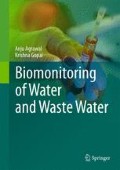Abstract
Cyanobacteria (blue-green algae) are natural inhabitants of fresh, brackish and marine waters, and they are worldwide in distribution. Cyanobacteria or blue-green algae occur worldwide especially in calm, nutrient-rich waters. Some species of cyanobacteria produce toxins that affect animals and humans. People may be exposed to cyanobacterial toxins by drinking or bathing in contaminated water. The most frequent and serious health effects are caused by drinking water containing the toxins (cyanobacteria) or by ingestion during recreational water contact. Cyanobacterial toxins are classified by how they affect the human body. Hepatotoxins (which affect the liver) are produced by some strains of the cyanobacteria Microcystis, Anabaena, Oscillatoria, Nodularia, Nostoc, Cylindrospermopsis and Umezakia. Neurotoxins (which affect the nervous system) are produced by some strains of Aphanizomenon and Oscillatoria. Cyanobacteria from the species Cylindrospermopsis raciborskii may also produce toxic alkaloids, causing gastrointestinal symptoms or kidney disease in humans. Not all cyanobacteria of these species form toxins and it is likely that there are as yet unrecognised toxins. People are mainly exposed to cyanobacterial toxins by drinking or bathing in contaminated water. Other sources include algal food tablets. Some species form a scum on the water, but high concentrations may also be present throughout the affected water. Surface scums, where they occur, represent a specific hazard to human health because of their particularly high toxin contact. Contact, especially by children, should be avoided. They produce a diverse range of small molecules which are hazardous to human and animal health. Their harmful effects range from mild to serious and include gastrointestinal upsets, skin irritations and liver and neurological damage. Reactive and proreactive measures of cyanobacteria are also defined. The reduction of cyanobacterial toxin problems in natural and controlled water as a potential benefit of eutrophication is also dealt with.
Access this chapter
Tax calculation will be finalised at checkout
Purchases are for personal use only
References
Anderson WB, Slawson RM, Mayfield EI (2002) A review of drinking water associated endotoxin including potential routes of human exposure. Can J Microbiol 48:567–587
Arando-Rodriguez R, Kubwabo C, Benoit FM (2003) Extraction of 15 microcystins and nodularin using immunoaffinity columns. Toxicon 42:587–599
Carmichel WW (1997) The cyanotoxins. In: Callow JA (ed) Advances in botanical research, vol 27. Academic, London/New York, pp 211–256
Codd GA (1995) Cyanobacterial toxins: occurrence, properties and biological significance. Water Sci Technol 32:149–156
Codd GA, Metcalf JS, Ward CJ, Beattie KA, Bell SG, Kaya K, Boon GK (2001) Analysis of cyanobacterial toxins by physicochemical methods. J AOAC Int 84:1626–1635
Falconer IR (1998) Algal toxins and human health. In: Hrubec J (ed) The handbook of environmental chemistry 5 part C. Springer, Berlin, pp 53–82
Fitzgeorge RB, Clark SA, Keevil CW (1994) Routes of intoxication. In: Codd GA, Jefferies TM, Keevil CW, Potter E (eds) Detection methods for cyanobacterial toxins. The Royal Society of Chemistry, Cambridge, pp 69–74
FWR (2000) Eutrophication of freshwaters. Review of current knowledge, FR/R 0002. Foundation for Water Research, Marlow, Buckinghamshire, 19 pp
Hershberger C, Binkley SB (1968) Chemistry and metabolism of 3-Deoxy-d-mannooctulosonic acid. I. Stereochemical determination. J Biol Chem 243(7):1578–1584. PMID 4296687
Kaebernick M, Neilan BA (2001) Ecological and molecular investigations of cyanotoxin production. FEMS Microbiol Ecol 35:1–9
Meriluto J (1997) Chromatography of microcystins. Anal Chim Acta 352:227–298
Metcalf JS, Codd GA (2003) Analysis of cyanobacterial toxins by immunological methods. Chem Res Toxicol 16:103–112
NRA (1990) Toxic blue green algae. Water quality series 2. National Rivers Authority, London, p 125
NSWBGATF (1992) Final report of the New South Wales blue-green algae task force. Department of Water Resources, Paramatta, p 159
Raetz C, Whitfield C (2002) Lipopolysaccharide endotoxins. Annu Rev Biochem 71:635–700
Rapala J, Lahti K, Rasanen LA, Esala AL, Niemala SI, Sivonen K (2002) Endotoxin associated with cyanobacteria and their removal during drinking water treatment. Water Res 36:2627–2635
Rittig MG et al (2004) Smooth and rough lipopolysaccharide phenotypes of Brucella induce different intracellular trafficking and cytokine/chemokine release in human monocytes. J Leukoc Biol 5(4):196–200. doi:10.1189/jlb.0103015. PMID 12960272. doi:10.1007/s101569900025. PMID 11810516
Scottish Executive (2002). Blue green algae (Cyanobacteria) in inland water assessment and control of risks to public health. Scottish Executive Health Department, Edinburgh, p 44
Sivonen K, Jones G (1999) Cyanobacterial toxins. In: Chorus I, Bartram J (eds) Toxic cyanobacteria in water. E and F.N. Spon, London, pp 41–111
Stewart I, Schluter PJ, Shaw GR (2006) Cyanobacterial lipopolysaccharides and human health – a review. Environ Health 5:7. doi:10.1186/1476-069X-5-7. PMC 1489932. PMID 16563160
Yoo RS, Carmichael WW, Hoehn RS, Hrudey SE (1995) Cyanobacterial (blue green algal) toxins: a resource guide. American Waterworks Association Research Foundation Boulder, Colorado, p 229
Author information
Authors and Affiliations
Rights and permissions
Copyright information
© 2013 Springer India
About this chapter
Cite this chapter
Agrawal, A., Gopal, K. (2013). Toxic Cyanobacteria in Water and Their Public Health Consequences. In: Biomonitoring of Water and Waste Water. Springer, India. https://doi.org/10.1007/978-81-322-0864-8_13
Download citation
DOI: https://doi.org/10.1007/978-81-322-0864-8_13
Published:
Publisher Name: Springer, India
Print ISBN: 978-81-322-0863-1
Online ISBN: 978-81-322-0864-8
eBook Packages: Earth and Environmental ScienceEarth and Environmental Science (R0)

